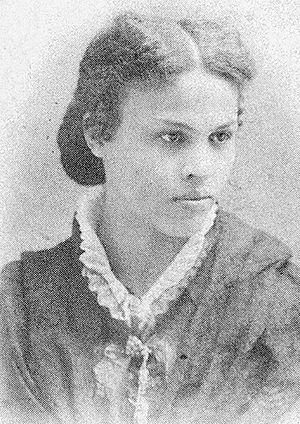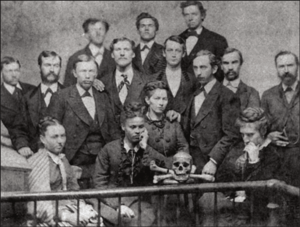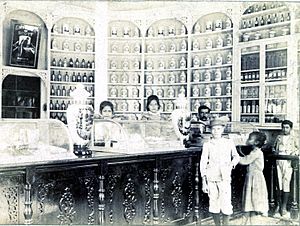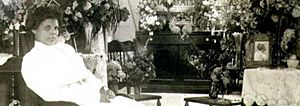Sarah Loguen Fraser facts for kids
Quick facts for kids
Sarah Marinda Loguen Fraser
|
|
|---|---|
 |
|
| Born |
Sarah Marinda Loguen
January 29, 1850 Syracuse, New York, U.S.
|
| Died | April 9, 1933 (aged 83) Washington, District of Columbia, U.S.
|
| Nationality | American |
| Alma mater | State University of New York Upstate Medical University (MD) |
| Known for | First female physician to practice medicine in the Dominican Republic |
| Scientific career | |
| Fields | Family medicine, obstetrics, and pediatrics |
Sarah Marinda Loguen Fraser (born January 29, 1850 – died April 9, 1933) was an amazing American doctor and children's doctor. She was one of the first African-American women to become a doctor in the United States. She was also the very first female doctor in the Dominican Republic.
Contents
Early Life and Dreams of Becoming a Doctor
Sarah Fraser was the daughter of Jermain Wesley Loguen. He was a famous abolitionist, meaning he worked to end slavery. Her mother was Caroline. Sarah was born in Syracuse, New York, and was one of eight children.
Their family home was a key stop on the Underground Railroad. This was a secret network that helped about 1,500 enslaved people escape to freedom in Canada. Growing up, Sarah saw many people who needed help. They often had injuries or illnesses from their difficult journeys.
Sarah decided to become a doctor when she was very young. She saw a boy trapped under a wagon and promised herself, "I will never, never see a human being in need of aid again and not be able to help." Her family doctor, Michael D. Benedict, supported her dream. She even spent five months learning from him. Later, he became one of her teachers in medical school.
When she was 23, Sarah was accepted into Syracuse University School of Medicine. This school is now called State University of New York Upstate Medical University. In 1873, a local newspaper celebrated her enrollment. They wrote that her choice was a great step for women's rights.
Education and Medical Training

In 1876, Sarah Fraser made history. She became the first woman to earn a medical degree (M.D.) from Syracuse University School of Medicine. An M.D. is the highest degree for doctors. She was likely only the fourth African-American woman to become a licensed doctor in the U.S. She was also the first to graduate from a medical school that allowed both men and women to study together.
After medical school, she continued her training. In the fall of 1876, she interned at the Woman's Hospital of Philadelphia. There, she focused on caring for children and helping with childbirth. She then moved to the New England Hospital for Women and Children in 1878. This hospital was special because only women worked there. It was here that Sarah developed a strong interest in helping mothers and babies.
While training, Sarah tried an interesting experiment. She gave upset patients soft, colorful yarn to knit with. She remembered how soft colors helped her feel calm when she was stressed. This idea helped calm her patients. It is thought to be an early example of using the idea of color psychology in a hospital.
A Trailblazing Medical Career
In 1879, Dr. Fraser opened her own medical office in Washington D.C.. She lived there with her sister Amelia and Amelia's husband, Lewis Douglass. Lewis was the son of the famous abolitionist Frederick Douglass. People started calling Sarah "Miss Doc," a nickname that stayed with her throughout her career.
In 1884, Dr. Fraser moved to the Dominican Republic. The president at the time, Fernando Arturo de Meriño, gave her a special license. This made her the first woman allowed to practice medicine in the Dominican Republic. However, because she was a woman, she was only allowed to treat women and children. Her family earned enough money from their drug store. This allowed Dr. Fraser to offer free medical care to people who could not afford it.
After her husband passed away in 1894, Sarah stopped her medical practice for a while. She focused on running the family pharmacy in Puerto Plata. This pharmacy was a popular place in the neighborhood. In 1896, she closed the pharmacy. She used the money to move herself and her daughter, Gregoria, to Washington D.C..
In 1907, Dr. Fraser started practicing pediatric medicine again from her home in Syracuse, New York. She also helped train black midwives. She was unique because she was both a university-trained doctor and a midwife. This allowed her to help people who often did not have good medical care. She wrote in her journals that helping people of her own race was all the "Heaven" she wanted.
Later, she faced some money problems. She briefly worked at the Blue Plains Industrial School for Boys in Maryland. However, she left because of unfair treatment. She also worked briefly at a women's clinic in Washington D.C., but left due to racism from some of her white coworkers.
Personal Life and Family

After medical school, a white classmate asked Sarah to marry him. He said it would help her career. But she said no. While in Washington D.C., she started writing letters to a chemist named Dr. Charles Fraser. Their family friend Frederick Douglass encouraged their relationship. He even helped them meet. Sarah and Charles married in 1882. Soon after, they moved to Charles' home in Puerto Plata in the Dominican Republic.
On December 23, 1883, Sarah gave birth to her daughter, Gregoria Alejandrina. She was named after her godfather, Gregorio Luperón. Only a local midwife helped with the birth. Sarah had some health problems after childbirth, which meant she could not have more children.
In 1894, Charles Fraser died from a stroke. With no reason to stay in the Dominican Republic, Dr. Fraser moved back to Washington D.C. in early 1897. She was not happy with the racism in American schools. So, she sent her daughter to boarding school in Neuilly-sur-Seine in France. From 1897 to 1901, Sarah and her daughter often traveled between Washington and France.

In 1901, she and her daughter settled in Washington D.C. Sarah Loguen Fraser passed away at her home in Syracuse, NY, on April 9, 1933. She died from kidney disease and Alzheimer's disease.
Lasting Legacy
When Sarah Fraser died in 1933, the Dominican Republic honored her greatly. They declared nine days of national mourning, and flags were flown at half-mast.
In Syracuse, a small park honors the Loguen family. It includes a mural of them. The Child Care Center at Upstate Medical University is named after Sarah. Each year, Upstate also gives out the "Sarah Loguen Fraser Scholarship." This scholarship helps a medical student who needs financial aid and shares Dr. Fraser's ideals.
In recent years, Upstate has celebrated "Sarah Loguen Fraser Day" in February. This is usually part of Black History Month. Dr. Fraser is buried at Lincoln Memorial Cemetery in Suitland, Maryland.
Images for kids


